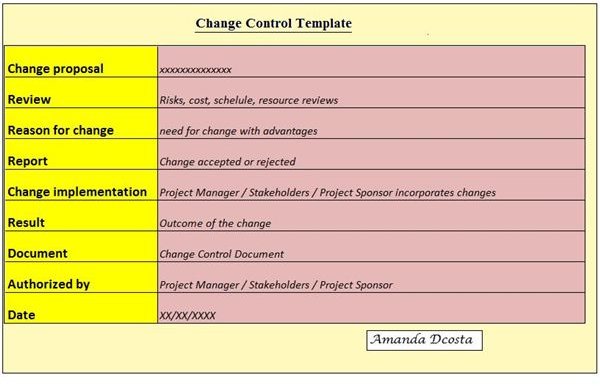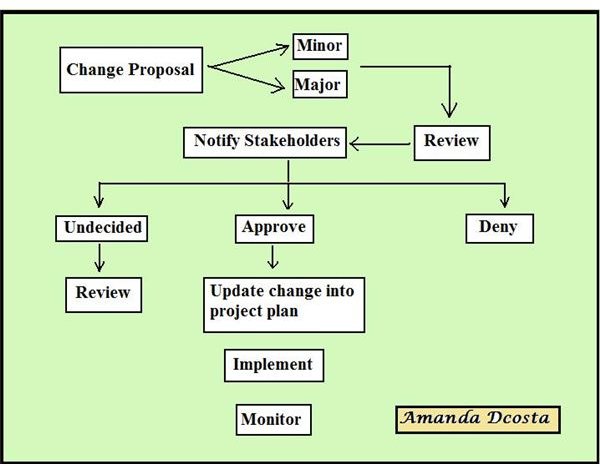Creating a Change Control Plan: Key Components & Free Sample Template
Not every project goes through a project plan from start to finish as initially planned. There may be circumstances in a project that makes it inevitable for change to happen, whether minor or major, especially when some unforeseen event happens or a risk is identified. Sometimes these changes might happen during the initial stages of a project while some may happen during the latter half of the project, perhaps during its implementation.
Changes in a project plan hence calls for a change control plan which is meant to guide a project during the process of change. The attached diagram gives a simplified illustration of this change control process. You can also download a free change control plan from Bright Hub’s media gallery.
Change Control Process
The need for change is brought about as a result of some event that happens or a risk identified during the stages of a project. It is not present in the project plan and has to be proposed based on informative and supporting data that is meant to be in favor of the change. The steps towards changes in a project plan constitute what is known as the change control plan. The following points highlight a sample of a change control plan:
- Change generated: It is only after a thorough and thoughtful process that the need for change in the project plan is seriously taken into consideration. As mentioned earlier, it may be the result of a risk identified or an unforeseen block that the project might encounter. Whatever it may be, when a positive change is identified, the project manager or any of the stake holders can take the initiative to generate the change.
- Change Proposal: Once a change is identified and generated, it is put forward to all the stakeholders in the form of a document known as the change proposal. This proposal gives a written explanation of the drawbacks in the current project, how the new change will benefit the project and what the possible risks may be. In effect, it upholds the claim for a positive project change and how it can benefit all stakeholders in terms of monetary, resource, and schedule constraints.
- Review: Once the change proposal has officially been put forward to the board of stakeholders, it is reviewed thoroughly. Remember, not all proposed changes need to be accepted. However, if the benefits of the change can be warrantied for, the change might be approved. If it does not meet expectations it may either be left unapproved for further review, which can delay the project, or even be denied. Hence, before a proposal has been created for submission, a lot of thought, study and investigation has to go into it.
- Change Approval: Once a change has been approved, it has to be integrated into the system. Hence all that follows before implementation is the official, written changes to the existing project plan. This change approval has to be counter signed by all the stakeholders or at least members of the top management, such as the project sponsor, review board and the project manager.
- Implement: The changes that are made to the project plan are now ready to be implemented and the project carries on as initially planned with the necessary changes added to it. These changes have to be monitored just as any other stage of the project is monitored, and all documented information about the change is added to the change control plan details.
Citing a Change Control Plan Sample
Let us take the retail industry for example. A new store is to be launched. As per plan, it should have five bays assigned for the General Merchandising Department and four bays assigned for the Crockery section. However, due to a forecast in sales breakup, there is a suggested plan for the five bays in General Merchandising to be minimized to four and the four bays for Crockery to be increased to five. Although there would hardly be any physical restructuring of the plan, it would call for a change in the departmental planogram of each department.
Before these changes are made, and let’s assume they are unanimously suggested, there would have to be an official change in the retail project plan first. This change would have to be officially initiated by the Project Manager (in writing), analyzed with risk references or advantages mentioned and consent in writing from all the members or stakeholders involved. The official process of change is part of a document known as the Change Control Document. It is part of the collection of project documents and validates the changes that have to be made.
Project Change Control Template
This template, which you can download for free from Bright Hub’s media gallery, gives you an idea of how the changes are made and incorporated.

Change proposal: To convert the Fifth bay of the General Merchandising Department to the fifth bay for the Crockery Department.
Review: All stakeholders reviewed the change proposition while citing reasons of possible risks or reasons for its advantage. Schedule, Cost and Resource variables were also reviewed.
Reason for change: The review suggested a proportional higher percentage of sales in the Crockery Department without affecting General Merchandising sales considerably.
Report: Change accepted by all stakeholders
Change implementation: Changes were officially made to the project plan.
Result: Four bays in GM and five bays in Crockery
This document, the change control plan document becomes a part of all documents in the project and a part of the project close-out report. All cost, time, resource, manpower and technical values have to be documented to help round up the change control plan. This document may also be used as the basis for further similar project plan creation.
Image credits: Author, Amanda Dcosta
